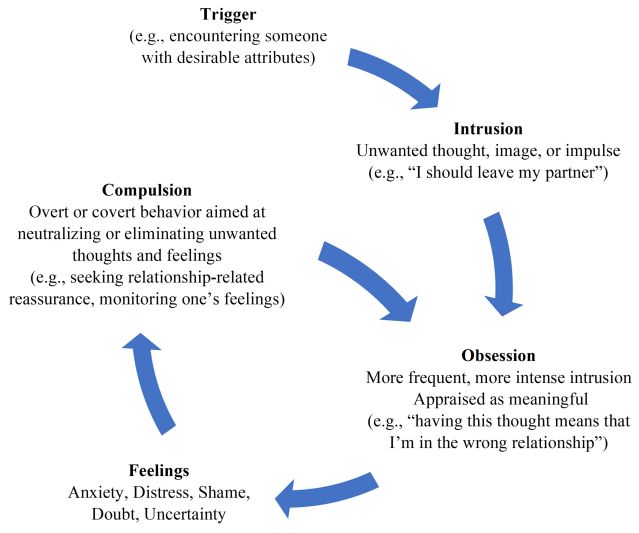OCD
Breaking Down the Cycle of Relationship OCD
Navigating the circular process of obsession in romantic relationships.
Posted January 27, 2023 Reviewed by Devon Frye
Key points
- Relationship obsessive-compulsive disorder (ROCD) is characterized by persistent and distressing doubts regarding one's romantic relationship.
- Behavioral, emotional, and cognitive components underlie a cycle of struggling with relationship-related thoughts and feelings.
- Differentiating between the automatic and controllable elements of the ROCD cycle is the initial step toward breaking the cycle.
Relationship OCD (ROCD) is a manifestation of obsessive-compulsive disorder (OCD) in which one’s relationship becomes the focus of obsessions and compulsions. While relationship-related doubts and questions arise naturally in romantic relationships, for people with ROCD such doubts and questions often become a source of ongoing distress and anxiety, leading them to engage in compulsions and continuously struggle with their thoughts and feelings in a circular, incapacitating manner.
The construct of ROCD, which has received increasing clinical and research focus throughout the past decade, was initially described by Prof. Guy Doron and Dr. Danny Derby, with whom I currently practice. ROCD is a type of OCD. It is not listed in the DSM-5 as a distinct diagnosis; rather, it describes a particular way that a diagnosis of OCD can manifest. As such, Prof. Doron and Dr. Derby’s conceptualization of the ROCD phenomenon allows us to better understand the process that takes place when people obsess over their relationships, and to offer a suitable therapy.
To better understand the processes occurring when people obsess over their relationships and to discuss effective coping, we’ll dive into the components that construct the circular obsessive-compulsive process, also referred to as the ROCD cycle.
The ROCD Cycle
Similar to cycles occurring in other presentations of OCD, several cognitive, emotional, and behavioral processes underlie the ROCD cycle. The cycle typically starts with a trigger that leads to an intrusive thought and culminates in prolonged, circular struggles with one’s thoughts and feelings.

Intrusions: Intrusions are thoughts, images, or impulses that are experienced as unwanted, uninvited, and often unpleasant. Experiencing intrusions is a natural phenomenon reported by most people. Research shows that people without OCD frequently experience a variety of intrusions, including thoughts, images, or impulses about hurting, insulting, or criticizing others, jumping in front of vehicles or off high places, crashing their car while driving, engaging in violent or undesirable sexual acts, shoplifting, or having a catastrophe befalling a loved one (Purdon & Clark, 1993; Rachman & de Silva, 1978).
In the context of romantic relationships, intrusions may include thoughts like “I should leave my partner.” Intrusions are often triggered by external factors such as watching romantic movies, meeting people with desirable attributes, seeing other couples interact, or talking about commitment-related issues. At other times, intrusions pop up in the absence of distinct, external triggers, and may emerge in the context of daily experiences, such as boredom.
Intrusions are automatic in nature. Although people do not typically wish to experience intrusive thoughts or images, they still pop up in our minds uncontrollably. However, people who do not suffer from ROCD typically dismiss these intrusions easily and quickly brush them off.
Obsessions: Several features distinguish natural intrusions from clinical obsessions. First, obsessions involve more intense, more discomforting, and more frequent intrusive experiences. Second, natural, unwanted intrusions may escalate into obsessions when people appraise these intrusions as meaningful and telling about themselves, their partners, or their relationships (Doron et al., 2014).
For example, while many people could rapidly dismiss the intrusive thought “I should leave my partner,” people with ROCD might think that “having such a thought indicates that I might be in the wrong relationship.” Hence, intrusions and obsessions are situated at different points on a continuum and are typically distinguished not in quality but in quantity, intensity, and in the meaning attached to them.
Feelings: Intrusions and obsessions are often accompanied by uncomfortable feelings, such as anxiety, distress, shame, disgust, anger, doubt, uncertainty, or a sense that things are not "just right." Naturally, in the case of obsessions, these feelings tend to be more intense and more discomforting.
Compulsions: When trapped in the ROCD cycle, people often feel compelled to respond to their obsessions with a variety of behaviors called compulsions (or rituals). Compulsions are behaviors that people engage in to neutralize, counteract, or rid themselves of their uncomfortable thoughts and alleviate the discomfort caused by their obsessions. Compulsive behaviors are often aimed at achieving an urgent resolution to relationship-related doubts and regaining a sense of certainty about the relationship.
Some compulsions manifest as overt, external behaviors, such as seeking reassurance from others regarding the rightness of one’s relationship or avoiding triggering situations such as meeting other couples or watching romantic movies. Other compulsions manifest as covert, internal behaviors, such as bringing to mind thoughts that oppose one’s obsessions or monitoring one’s feelings toward their partner. For example, in response to the thought “I should leave my partner,” one may start monitoring their feelings towards their partner and check whether they feel in love or call a friend to ask for their opinion about the 'rightness' of the relationship.
Importantly, compulsive behaviors are not defined by the content of the behavior, but by its objective. Calling a friend and discussing one’s relationship is not a compulsion in itself. However, the same call would serve as a compulsion if it takes place in the context of experiencing a distressing obsession (e.g., “I should leave my partner”) and with the aim of ridding oneself of that thought, reducing distress, or urgently achieving a relationship-related sense of resolution.
Although compulsions may provide temporary relief from obsession-related distress, they come with a significant personal price. The use of neutralizing compulsions increases the salience of obsessions and intensifies the meaning attached to them. The more one struggles with intrusive thoughts, the more meaningful these thoughts become, thus increasing their frequency and associated discomfort.
Hence, the stronger the vicious ROCD cycle becomes, the more one feels compelled to respond to their frequently arising obsessions in a way that may significantly disrupt daily life and results in prolonged personal and relational distress.
Breaking the Cycle
A key element in breaking the ROCD cycle is to distinguish its automatic parts from the more controllable ones. As mentioned above, intrusive thoughts, images, and impulses arise automatically. Similarly, one has little control over the uncomfortable feelings that accompany ROCD intrusions. Hence, when reacting compulsively to intrusions and feelings, people with ROCD struggle with automatic processes over which they have very little control.
While one cannot stop intrusions from automatically manifesting, one can reduce compulsive reactions to these intrusions and give up attempting to eliminate the associated unwanted thoughts and feelings. While it is normal to have unwanted relationship-related thoughts and feelings, the way we respond to them greatly impacts how we manage our personal and relational lives.
Treatments that are aimed at breaking the obsessive-compulsive cycle, such as cognitive-behavioral therapy (CBT), focus on breaking the link between one’s distressing feelings and the use of compulsions (Abramowitz, 2006). Such therapies strengthen clients’ abilities to sustain their distress and let it subside naturally while providing them with effective tools to reduce their use of compulsions.
By doing so, one reduces the influx of "fuel" that keeps the obsessive-compulsive cycle running. With time, clients learn to detach the meaning given to their intrusions and to stop seeing them as experiences that call for urgent action.
A common source of confusion for clients and therapists alike is that one’s relationship-related intrusions often revolve around themes that are important to them. Hence, at times people wish to consider relationship-related aspects such as the suitability of their relationship.
However, when one is trapped in the ROCD cycle, they are mainly focused on ridding themselves of their unwanted thoughts and relieving the distress. Once the obsessive-compulsive cycle has weakened, one can go back and contemplate any relationship-related questions which are important to them, and consider them in a flexible, constructive manner.
To know more about Relationship OCD, click here.
References
Abramowitz, J. S. (2006). Understanding and treating obsessive-compulsive disorder: A cognitive behavioral approach. Routledge.
Doron, G., Derby, D. S., & Szepsenwol, O. (2014). Relationship obsessive compulsive disorder (ROCD): A conceptual framework. Journal of Obsessive-Compulsive and Related Disorders, 3(2), 169–180.
Purdon, C., & Clark, D. A. (1993). Obsessive intrusive thoughts in nonclinical subjects. Part I. Content and relation with depressive, anxious and obsessional symptoms. Behaviour research and therapy, 31(8), 713–720.
Rachman, S., & de Silva, P. (1978). Abnormal and normal obsessions. Behaviour research and therapy, 16(4), 233–248.




